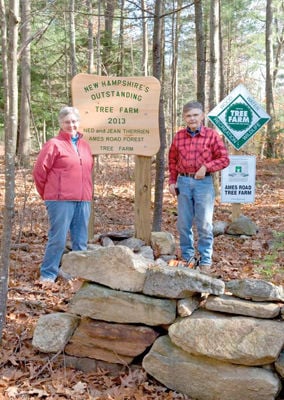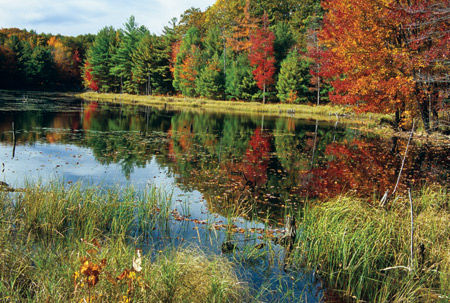Ned and Jean Therrien have done an exemplary job over the last 36 years managing their forestland for the multiple use concepts that the Tree Farm program promotes. Since the 119-acre property was purchased back in 1980, the Ames Road Forest has been managed carefully and thoughtfully. Ned maintains meticulous records showing management activities, financial return, and dollars spent on improvements. They have spent well over 13,000 hours improving the Ames Road Forest. (Courtesy photo)
Gilford couple named Northeast Region Outstanding Tree Farmers
By THOMAS P. CALDWELL, LACONIA DAILY SUN
GILFORD — The biggest obstacle to overcome in Ned and Jean Therriens’ journey to being named Northeast Region Outstanding Tree Farmers was the initial land purchase.
Local resident Ned Therrien, a retired forester who had worked for the U.S. Forest Service for 30 years, said there has been plenty of hard work along the way, but buying their 118-acre property off Ames Road in Canterbury in the first place was the most difficult step.
“When we bought it in 1980, we were both working and not making a lot of money,” Therrien said, “but, like any investment, the hope is that, over the long run, we’d get a good return on the investment.”
There have been four timber harvests since that time, with a timber sale currently under way, but apart from the economic benefits, Ned and Jean Therrien gained recognition in 2013 as New Hampshire’s Outstanding Tree Farmers and, this month, as Northeast Region Outstanding Tree Farmers.
The recognition by the American Tree Farm System means the Therriens are in the running for the title of U.S. Outstanding Tree Farmers.
To qualify for the competitive designation, tree farmers have to show that, over the years, they have managed their property to grow healthy trees while protecting wetlands and soils and, in most cases, worked to increase wildlife habitat. They must must “exhibit the most exceptional forest stewardship to protect and improve our forest resources, and must promote forest stewardship within their communities,” according to the American Tree Farm System.
A committee of tree farmers and foresters goes over the property and the tree farm’s management plan to determine who is doing the best job among those considered for the honor. It begins at the state level, which then puts the winners into a regional competition and, finally, into competition for the national honor.
There are 73,000 tree farmers in the country, with four regional winners. Others named Regional Outstanding Tree Farmers on July 6 were Glenn and Scarlett Riley of Abbeville, Alabama; Jim Ball of Parkville, Missouri; and the Chrisman Family of Kalispell, Montana.
“Tree farmers represent some of the most passionate and dedicated forest owners in the U.S.,” said Tom Martin, president and chief executive officer of the American Forest Foundation, the organization that oversees the American Tree Farm System. “These individuals actively care for their land, create needed wildlife habitat, protect clean water, stimulate local economies and more. Our Outstanding Tree Farmers of the Year take this duty above and beyond, and we are proud to honor them and share their stories and accomplishments.”
The Therriens’ Canterbury tree farm includes the 12-acre Otter Pond and 4-acre Merganser Pond, both of them with active beaver colonies, as well as a small brook. The property is bounded by stonewalls and is forested with white pine, red oak, red maple, hemlock, red pine, ash, black birch, sugar maple, and beech trees.
The U.S. Forest Service had transferred Therrien to its Laconia headquarters, which at the time had oversight of the White Mountain National Forest, in the 1970s, and they purchased a home in Gilford.
“We looked for four years to find a property with some water in a reasonable distance from Gilford,” Ned Therrien said, “and with decent timber that we could manage over the long term to give us some economic return.”
While many tree farmers are not foresters, Therrien had an advantage as a graduate forester. Still, he said, “There is certainly a lot of help for a person without a forestry background, and we’ve used consulting foresters and biologists to help us.”
After purchasing the land, Therrien did an inventory of the forest. “You’ve got to know what you’ve got,” he said.
The survey determined the type of trees on the property and how many of each, and he set up 58 permanent plots that he would return to every 10 years to update the inventory, with additional plots to refine the numbers. Therrien uses a computerized inventory system to calculate the volume by species.
“Once you get enough volume, then you start thinning the trees,” Therrien said. He began by taking out the poor-quality timber to allow the better-quality trees to grow. “I’ve done a tremendous amount of work thinning them out,” he said, noting he has put in 14,000 hours of work to care for the property since purchasing it.
He clears the small timber lots himself, but for larger harvests, he hires professional loggers with heavy machinery. Oak saw timber that is 14 inches and above gets shipped to China, while the pine goes to Diprizio Pine Sales of Middleton, which ships lumber throughout the United States.
Timber harvesting is only one part of tree farm management, Therrien said. It also involves creating and sustaining wildlife habitat. The Ames Road Forest includes managed habitats for more than 100 species of birds, as well as five vernal pools that fill with water during the spring but dry up during the summer, making them unsuitable for fish, but they are ideal for amphibians.
“Because of changes in the climate, amphibians are having a very difficult time,” Therrien said. “Maintaining vernal pools is important.”
The landings, created to process the timber, get cleaned up and converted to wildlife habitat. “We turn the soil over and seed and fertilize it and turn it into grassland,” Therrien said. He also maintains the roads through the property, mowing them to create high-quality habitat for both mammals and birds.
The property is home to whitetail deer, moose and black bear, as well as beaver, otters, mink and pine marten.
“If you work hard and do it right, you’re protecting wildlife and you hope to have enough good timber to get a good return,” Therrien said. “But there are no guarantees.”
One threat to the forest is the arrival of the emerald ash borer. Therrien said a couple of the trees already have ash borers. “In time, all of the ash trees will die,” he said.
Then there is the danger from wind storms or lightning strikes.
“The other big thing to overcome is that it’s a hell of a lot of work,” Therrien said. “To me, it’s enjoyable, but there’s still a lot of hard, physical work if you do it yourself. There’s a lot of help out there, but the onus is on the owner to do it right and leave the property in better shape than when you bought it.”
The Therriens granted a conservation easement to Five Rivers Conservation Trust in Concord, setting terms for protection of the land and its public use.
“I could have sold it for house lots, but I didn’t work on this property to just sell it and destroy all the work I’ve done,” Therrien said.
While the state taxes property on its optimum and best use — which means development — Therrien said, “The optimum and best use, in my opinion, is not house lots but clean water, clean air, and wildlife habitat. A conservation easement is a good thing, and makes it open to the public.”
Putting land in a conservation easement lowers taxes but also means a greatly reduced value when it comes time to sell.
But economics is not all that’s involved. Therrien said, “Forming a close relationship with the land is like a marriage. You become very aware of what goes on, and familiar with the wildlife and trees, and the changes, and the effect of management. It’s a personal and emotional thing that’s extremely satisfying.”



















(0) comments
Welcome to the discussion.
Log In
Keep it Clean. Please avoid obscene, vulgar, lewd, racist or sexually-oriented language.
PLEASE TURN OFF YOUR CAPS LOCK.
Don't Threaten. Threats of harming another person will not be tolerated.
Be Truthful. Don't knowingly lie about anyone or anything.
Be Nice. No racism, sexism or any sort of -ism that is degrading to another person.
Be Proactive. Use the 'Report' link on each comment to let us know of abusive posts.
Share with Us. We'd love to hear eyewitness accounts, the history behind an article.